In this article, you’ll learn what is Vice in the workshop? How to Use? Explained with its parts, types, construction, how each type of vice works with diagram. And also you can download the PDF file of this article.
What is Vice?
In a workshop, it is absolutely necessary to hold a job strongly for the purpose of carrying out the various operations like filing, drilling, chipping or milling, etc. The mechanical device used for holding jobs is called vice. Also, it can be said that a workshop is incomplete without a vice.
Types of Vice
For different jobs, different kinds of vice are used. The following are the types of vice:
- Bench Vice
- Simple Bench Vice
- Swivel Base Bench Vice
- Quick Release Vice
- Combination Vice
- Machine Vice
- Plain Machine Vice
- Flange Machine Vice
- Swivel Machine Vice
- Universal Machine Vice
- Vertical Machine Vice
- Pipe Vice
- Leg Vice
- Carpenter Vice
- Hand Vice
- Combination Hand Vice
- Pin Vice
- Tool Makers Vice
- Drill Vice
#1 Bench Vice:
The complete construction of this vice is made of cast iron. Both its jaws are made of tool steel. The spindle handle is made of mild steel. This vice is most widely used in a workshop.
Parts of Vice:
1. Base
2. Spindle
3. Handle
4. Fixed Jaw
5. Movable Jaw
6. Jaw Plate
Construction of Bench Vice:
The fixed jaw is cast along with the vice. The movable jaw is fixed with it. In both the jaws, the tool steel plate is attached with a plate screw, which has dents. It is because of these dents that the grip of the job is very strong. When the jaw plate is damaged it can be replaced.
The spindle is fitted opposite to the movable jaw, which is fixed with the help of a pin and a spring. This spindle sets in the threaded box-nut tightened in the fixed jaw. In the spindle and the box, nut square threads are cut.
The handle of the round rod is fixed in a hole made in the beginning part of the vice. By revolving this handle the movable jaw moves ahead or backward. Job is held between the two jaws. The size of the vice is taken from its breadth. Vice is tightened on the work table with two or three bolts.
#2 Simple Bench Vice:
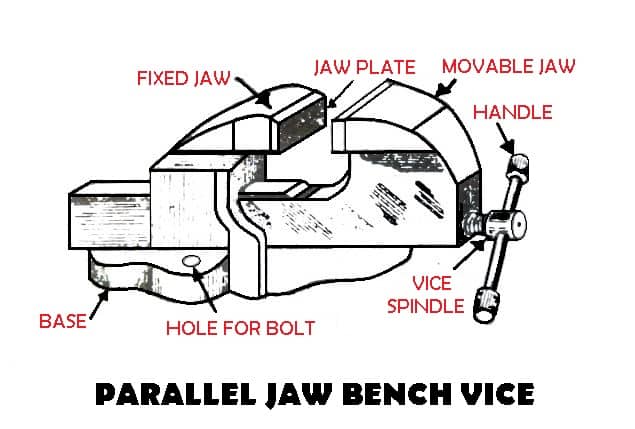
Complete details of this vice have been given above and it has been shown in Figure.
#3 Swivel Base Bench Vice:
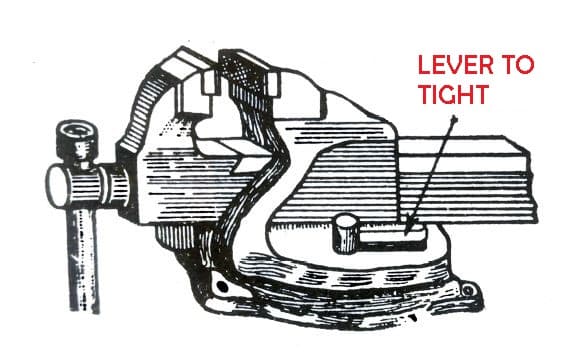
This vice is almost similar to the simple bench Vice. But its lower base is constructed in such a way that it could be swiveled. For swiveling it the tightening lever fixed at the base is loosened and after swiveling it as desired, again the lever is tightened.
One advantage of using this vice is that having fastened the job once, we can revolve the job in any direction for doing different operations like filing, chipping, etc. It saves time. This vice has been shown in the figure.
#4 Quick Release Vice:
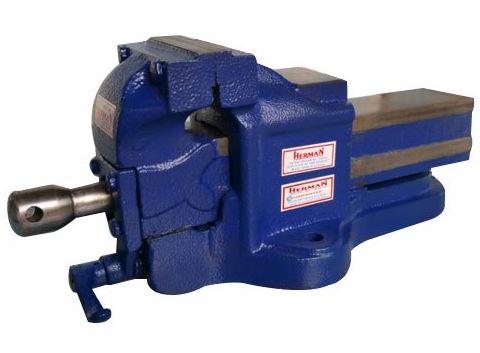
In this type of vice, buttress threads are cut on the spindle and a half nut is used with it. On one side of the spindle, a release lever is fixed. which can be pressed to pull out the movable job without revolving the spindle. When the lever is pressed half nut is pressed down and the contact between spindle and nut is disconnected.
As soon the pressure from the lever is released the nut comes to its previous position with the help of spring and at this time this vice works like an ordinary vice. The main facility provided by this vice is that for carrying out various operations like filing, chipping, scraping, etc. job can be frequently fastened or dismantled. These types of vice have been shown in Figure.
#5 Combination Vice:
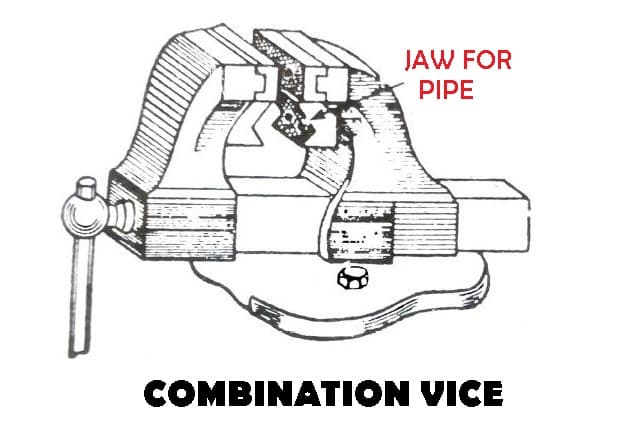
It is a very useful vice. In this vice under both the parallel Jaws “V” shaped jaws are also made. Thus, along with the flat job, round pipes and rods etc. can be easily held, It has been shown in Figure.
#6 Machine Vice:
It is necessary to hold a job strongly for carrying out drilling, milling, slotting, or shaping. For holding the job for these operations machine vice is used. This machine vice is fastened on the table. For fastening it on the table “T” bolts are used, which fasten the vice firmly and easily in the “T'” slot made in the table.
Plane Machine Vice:
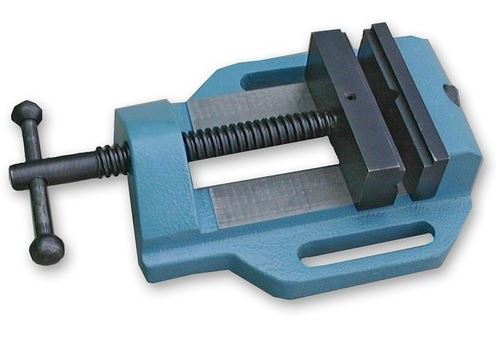
It has been shown in Figure. This machine is used to fasten light jobs. It is also known as light-duty machine Vice. Its fixed jaw is long in size. Or this the movable jaw moves ahead or backward on revolving the spindle.
Flange Machine Vice:
This vice is also called heavy duty machine vice. This vice is used for fastening such jobs which get frequent shocks at the time of machining. On one end of the spindle, a square end is made in which a box type handle is fixed to revolve it.
Swivel Machine Vice:
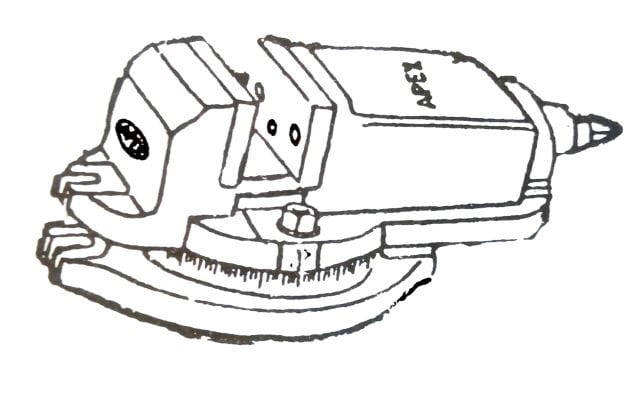
In construction and shape, this vice is similar to a flange machine vice but its base is different, with the help of this base, the vice can be revolved at any angle. Its advantage is that without separating the job from the vice straight or angular machining can be done. This types of machine Vice has been shown in Figure.
Universal Machine Vice:
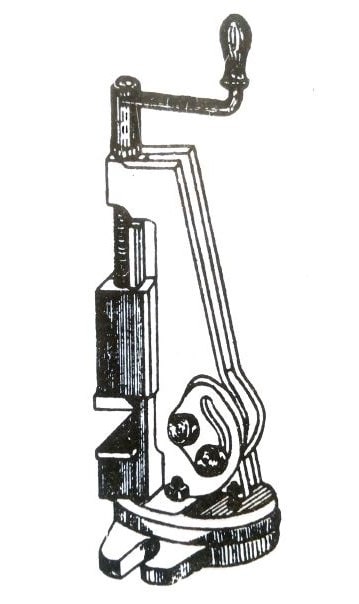
This is a highly useful machine vice. The speciality of this machine vice is that with it job can be held in vertical, horizontal or angular position. It is mostly used in tool-making. One machine of this type is shown in Figure.
Vertical Machine Vice:
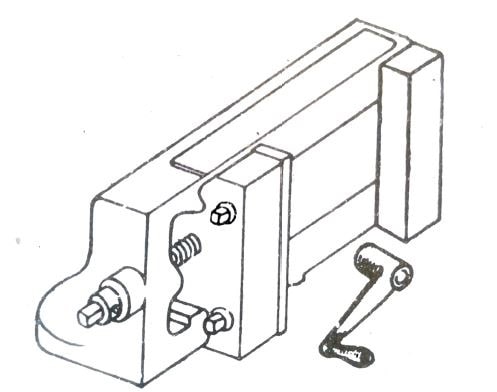
This vice different from all other types of vice because in this vice jobs are held in a vertical manner. Instead of jaws here are flanges in this vice. With this vice of the can, he easily held for machining. This type of vice has been shown in Figure.
#7 Pipe Vice:
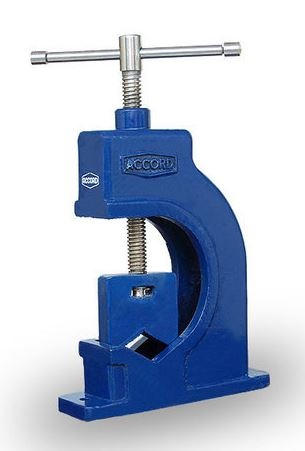
Spindle and jaw are fitted vertically in this vice. Its jaws are of “V” shape and dents are cut in these jaws. That’s why this vice performs the job of holding the pipe and round jobs easily and firmly. In its jaw “V” is made 90° angle. In Figure Pipe Vice has been shown.
#8 Leg vice:
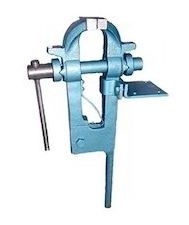
It is generally used in the blacksmithy shop. A hot job is fastened in it and blacksmithy operations like forging, bending, etc. are done. It is fitted in the workbench in a hanging manner. It contains one leg. which is straightway placed on wood.
Movable jaw and fixed jaw are joined with each other through a hinge. Between these two jaws, a strong spring leaf is fixed, with whose help movable jaw handle opens easily when revolved. On the upper side of both the jaws, a spindle is fitted in which square threads are cut.
A box nut is fitted in the fixed jaw because of this when the handle is revolved, the movable jaw opens towards the outside. This type of vice has been shown in the Figure.
Its entire body is made of a rought iron. That is why when we strike hammer blows it does not have any bad effect.
#9 Carpenter Vice:
This vice is used only for woodworks. Its spiders are made of iron but jaws are made of wood. It is used for holding wood and carrying out different operations on it. Buttress threads are cut on its spindle and spring is fitted in it. This vice also functions almost like the quick release vice.
#10 Hand Vice:
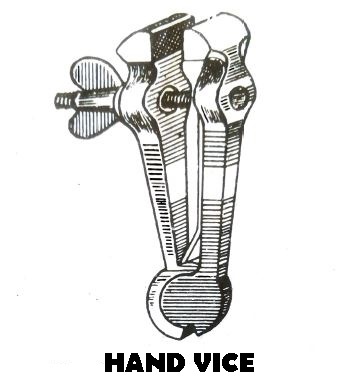
This vice is almost similar to the leg vice with a long leg and opens like that vice. Only small jobs can be held in this vice.
It cannot be fitted on a work bench. As per its name, it is held in hand. Instead of handle a wing nut is used which is attached on the spindle fixed between the two jaws. Between the two legs a spring loaye is fixed because of this it opens easily.
#11 Combination Hand Vice:
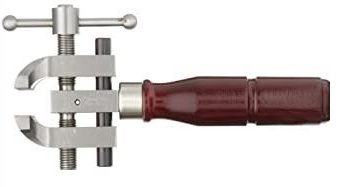
The combination hand vice has been shown in Figure. It can be used both in the form of a small bench vice and hand vice. By holding its vice handle it can be used as a hand vice. A base clamp is provided with it. With this clamp, it can be fitted on the bench also. In this way, it functions as a small bench vice.
Its distinguishing feature is that by loosening its wing nut, like a swivel vice, it can be fitted at any angle. This vice is made by the steel forging process. On its spindle Right Hand and Left-Hand threads are cut. so both the jaws open or close simultaneously.
#12 Pin Vice:
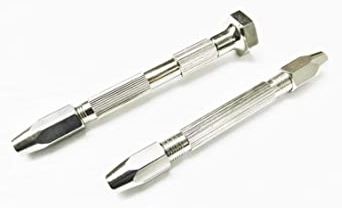
This vice works as a small drill chuck. There are three jaws like a chuck in this vice. The upper part is thin and long which is either knurled or it is made of six or eight panes. There is a hole across its body, in which long wires or pins etc. can be easily held.
Pin vice can be opened or tightened by holding it between the small finger and the thumb of the hand. It is used to hold small jobs like a screw, pin, etc. by the watchmakers or instrument makers.
#13 Tool makers vice:
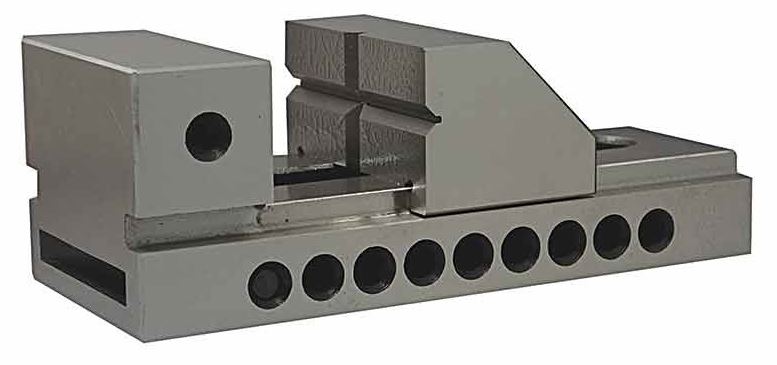
It is generally for holding non-ferrous metal jobs and other small jobs by the tool makers. Its jaws are made plain, which avoid bruising of the jobs. There is no need to fit this vice on the table etc. It can be held in hand or simply placed on a table for filing etc. It has been shown in Figures.
#14 Drill Vice:
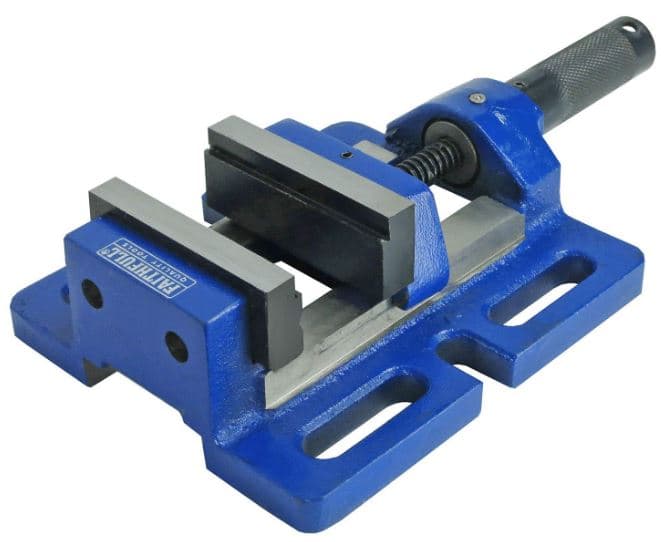
Drill vice is a special kind of machine, vice. It is used for holding the job while boring holes with the drilling machine. It is made of steel. A handle is attached to it. By lifting it up the jaws can be separated.
A threaded spindle is also provided for setting its strokes after lifting the handle. There is no need to tighten this machine drill on the table. It is kept on the table in the normal way and operated with the handle.
Conclusion
That’s it thanks for reading, I hope I have covered everything about types of vice. As we have vice is the most important tool in the workshop or we can say that a workshop is incomplete without a vice.
If you have any questions about “types of vice” you can ask in the comments I’ll respond to you. If you like this article then please share it with your friends.
Subscribe to our newsletter to get notification of our new posts.
Download the PDF file of this artcile
Read More:
- 14 TYPES OF WASHERS & HOW THEY USE? WITH [PICTURES & PDF]
- 32 DIFFERENT TYPES OF HAMMERS AND THEIR USES [WITH PICTURES]
Image Credit:
Indiamart: https://dir.indiamart.com/impcat/machine-vice.html
Checkout more about vice:
https://books.google.co.in/books?id=xNwDAAAAMBAJ&pg=PA233&redir_esc=y#v=onepage&q&f=false
Thanks for sharing this site.
You’re welcome. Keep visiting 😉
Can I get any information regarding fractal vise and its current uses in industries
Typically, a fractal vice is made up of a series of stacked arcs, so that each arc consists of two smaller arcs that are half the diameter. They are used to hold workpieces in complex forms.
Very informative! I am currently writing a book on the evolution of the four industrial revolutions. This paper spawned a great deal of thought, about, what if we didn’t have these? I’m a mechanical engineer from Houston, Texas, and have spent 55 or so years, working with energy, aerospace, marine drive systems, and the roll industry. From steel mills to thread spools, I’ve seen rolls. Inland and offshore drilling rigs gave me a thrill or two, as a result of needing a downhole or platform drilling tool NOW. My experiences will be out, possibly next year, in my autobiography!. Good luck and thanks again for the great paper.
You’re welcome, nice to hear about your experience, and thank you so much for reading our article.
Comment: Good morning sir,am greatful for your smashling hardworking.
Thank you so much 🙂